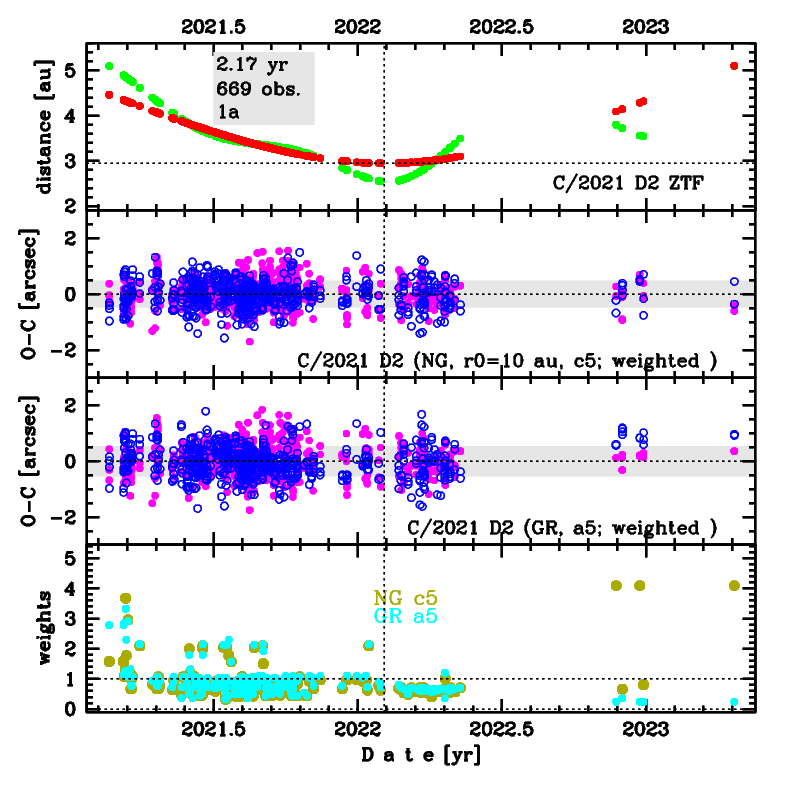C/2021 D2 ZTF
more info
Comet C/2021 D2 was discovered on 19 February 2021 by Palomar Mountain--ZTF, that is almost a year before its perihelion passage.
Comet had its closest approach to the Earth on 7 February 2022 (2.54 au), about four days after its perihelion passage.
The preferred NG solution given here is based on data span over 2.17 yr in a range of heliocentric distances: 4.46 au – 2.95 au (perihelion) – 5.10 au.
This Oort spike comet suffers small planetary perturbations during its passage through the planetary system that lead to escape the comet from the planetary zone on a hyperbolic orbit (see future barycentric orbits).
Comet had its closest approach to the Earth on 7 February 2022 (2.54 au), about four days after its perihelion passage.
The preferred NG solution given here is based on data span over 2.17 yr in a range of heliocentric distances: 4.46 au – 2.95 au (perihelion) – 5.10 au.
This Oort spike comet suffers small planetary perturbations during its passage through the planetary system that lead to escape the comet from the planetary zone on a hyperbolic orbit (see future barycentric orbits).
| solution description | ||
|---|---|---|
| number of observations | 669 | |
| data interval | 2021 02 19 – 2023 04 22 | |
| data type | perihelion within the observation arc (FULL) | |
| data arc selection | entire data set (STD) | |
| range of heliocentric distances | 4.46 au – 2.95 au (perihelion) – 5.1 au | |
| detectability of NG effects in the comet's motion | comet with determinable NG~orbit | |
| type of model of motion | GR - gravitational orbit | |
| data weighting | YES | |
| number of residuals | 1321 | |
| RMS [arcseconds] | 0.54 | |
| orbit quality class | 1a+ | |
| previous orbit statistics, both Galactic and stellar perturbations were taken into account | ||
|---|---|---|
| no. of returning VCs in the swarm | 5001 | * |
| no. of escaping VCs in the swarm | 0 | |
| no. of hyperbolas among escaping VCs in the swarm | 0 | |
| previous reciprocal semi-major axis [10-6 au-1] | 17.94 – 18.68 – 19.41 | |
| previous perihelion distance [au] | 4100 – 4460 – 4900 | |
| previous aphelion distance [103 au] | 99 – 103 – 107 | |
| time interval to previous perihelion [Myr] | 10.7 – 11.4 – 12 | |
| percentage of VCs with qprev > 20 | 100 | |
| previous_g orbit statistics, here only the Galactic tide has been included | ||
|---|---|---|
| no. of returning VCs in the swarm | 4574 | * |
| no. of escaping VCs in the swarm | 427 | |
| no. of hyperbolas among escaping VCs in the swarm | 0 | |
| previous reciprocal semi-major axis [10-6 au-1] | 16.09 – 16.79 – 17.61 | R |
| previous perihelion distance [au] | 790 – 1000 – 1300 | R |
| previous aphelion distance [103 au] | 113 – 118 – 123 | R |
| time interval to previous perihelion [Myr] | 12.5 – 13.3 – 14 | R |
| percentage of VCs with qprev > 20 | 100 | |
